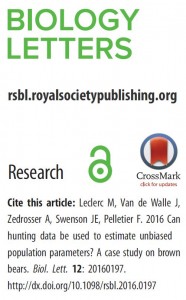 Scandinavian Brown Bear Research Project team published a new paper based on their long term studies, partially realized also within the GLOBE project. Authors underline that quantifying temporal changes in harvested populations is critical for applied and fundamental research. Because of the difficulty of collecting detailed individual data from wild populations, data from hunting records are often used. Yet, the hunting records not always represent a random sample of a population, so the authors aimed to detect and quantify potential bias in hunting records. They compared data gathered between 1996 and 2013 in a long-term monitoring project with the hunting records of brown bears (Ursus arctos) in Sweden. They checked the ratio of yearlings to adult females, yearling mass and adult female mass and concluded that the data from hunting records underestimated the decline in yearling and adult female mass over time, most likely owing to the legal protection of family groups from hunting, but reflected changes in the ratio of yearlings to adult females more reliably. Authors claim that although hunting data can be reliable to approximate population abundance, but they should be used with caution in management and conservation decisions, as they can represent a biased sample of a population.
Scandinavian Brown Bear Research Project team published a new paper based on their long term studies, partially realized also within the GLOBE project. Authors underline that quantifying temporal changes in harvested populations is critical for applied and fundamental research. Because of the difficulty of collecting detailed individual data from wild populations, data from hunting records are often used. Yet, the hunting records not always represent a random sample of a population, so the authors aimed to detect and quantify potential bias in hunting records. They compared data gathered between 1996 and 2013 in a long-term monitoring project with the hunting records of brown bears (Ursus arctos) in Sweden. They checked the ratio of yearlings to adult females, yearling mass and adult female mass and concluded that the data from hunting records underestimated the decline in yearling and adult female mass over time, most likely owing to the legal protection of family groups from hunting, but reflected changes in the ratio of yearlings to adult females more reliably. Authors claim that although hunting data can be reliable to approximate population abundance, but they should be used with caution in management and conservation decisions, as they can represent a biased sample of a population.
More info: Leclerc M., Van de Walle J., Zedrosser A., Swenson J.E., Pelletier F. 2016. Can hunting data be used to estimate unbiased population parameters? A case study on brown bears. Biology Letters 12: 20160197. http://dx.doi.org/10.1098/rsbl.2016.0197

